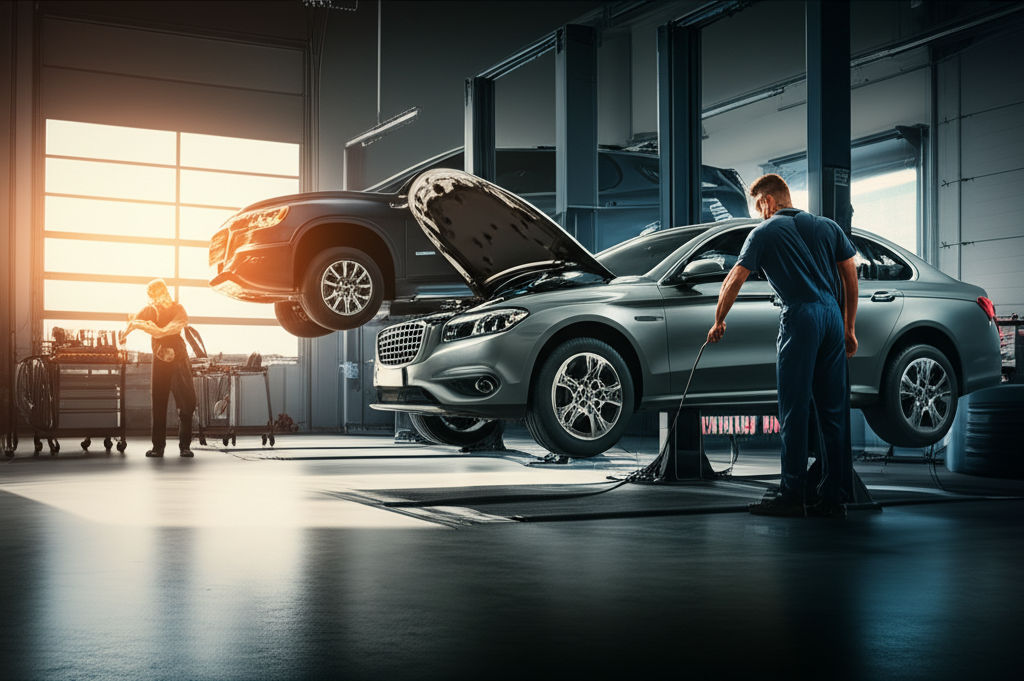Williams Automotive Care And Service Insights
Ellie Moore

Photo: Ensure a healthier, safer, and longer-lasting vehicle. Learn proactive car care insights from Williams Automotive to prevent costly repairs.
Williams Automotive Care and Service Insights: Your Guide to a Healthier Vehicle
Your car is more than just a mode of transport; it's an investment, a tool for freedom, and an integral part of your daily life. Just like any complex machine, it thrives on consistent care and attention. Ignoring its needs can lead to unexpected breakdowns, costly repairs, and even safety hazards. This is where understanding quality automotive care, exemplified by insights from a high-standard service provider like "Williams Automotive," becomes invaluable.
This article delves deep into the world of vehicle maintenance and repair, providing you with the knowledge to make informed decisions about your car's health. We'll explore the benefits of proactive care, how to interpret your car's warning signals, and what truly defines a trustworthy automotive service experience.
The Foundation of Automotive Longevity: Understanding Regular Car Maintenance
Many car owners view maintenance as a chore or an expense to be avoided until a problem arises. However, this reactive approach often leads to more significant, more expensive issues down the road. Embracing a proactive maintenance mindset is crucial for extending your vehicle's lifespan, ensuring its reliability, and maintaining its value. Regular maintenance, including routine checks and timely servicing, is a proactive step that saves you time, money, and hassle.
Why Proactive Care Trumps Reactive Repairs
Think of your car's maintenance like your own annual health check-up. Even when you feel great, a routine physical can detect minor issues before they become major health crises. The same applies to your vehicle. Preventive maintenance involves cleaning, replacement, and inspection of mechanical systems and parts, especially where wear and tear happen most frequently, such as wiper blades, tires, brakes, and the engine.
The benefits of preventive automotive care are substantial:
- Lowers the Risk of Future Trouble: Regular checks ensure your car stays in good shape, reducing the risk of future system failures. By supplying your car with better-condition replacement parts and fresh fluids, you prevent breakdowns later on.
- Prevents Costly Repairs: Addressing small issues early on can prevent them from escalating into major, expensive problems. For example, a simple oil change is far less costly than a full engine replacement.
- Enhances Safety on the Road: Critical components like brakes, steering, and tires are regularly inspected, reducing the risk of accidents caused by mechanical failures.
- Improves Fuel Efficiency: Well-maintained vehicles are more fuel-efficient. Properly inflated tires, fresh oil, and clean air filters contribute to better mileage, saving you money at the pump.
- Extends Vehicle Lifespan: Consistent care and timely addressing of issues reduce wear and tear, allowing your car to operate effectively for a longer period.
- Increases Resale Value: A vehicle with a documented maintenance history is more attractive to potential buyers and retains its value better.
The Essential Maintenance Checklist for Every Car Owner
While your owner's manual is the definitive guide for your specific vehicle, here's a general checklist of essential maintenance tasks:
- Oil and Filter Changes: Motor oil is the lifeblood of your engine, reducing friction and protecting components. Regular oil changes are crucial for optimal performance.
- Tire Rotation and Pressure Checks: Proper tire pressure improves handling, fuel economy, and safety. Regular rotation ensures even wear, extending tire life.
- Fluid Checks and Top-Offs: This includes brake fluid, coolant, power steering fluid, and transmission fluid. These fluids are vital for various systems to function correctly.
- Brake Inspection: Worn brake pads or low brake fluid can compromise your stopping power, a critical safety concern.
- Battery Check: Ensure terminals are clean and connections are secure to prevent starting issues.
- Filter Replacements: Air filters, cabin filters, and fuel filters all play a role in your vehicle's performance and efficiency.
- Belt and Hose Inspection: Over time, belts can crack and hoses can leak, leading to breakdowns. Regular checks can catch these issues before they fail.
- Light Checks: Ensure all exterior lights (headlights, tail lights, brake lights, turn signals) are functioning correctly for visibility and safety.
Decoding Your Vehicle's Language: Common Warning Signs and What They Mean
Your car is constantly communicating with you, often through subtle cues or, more explicitly, through its dashboard warning lights. Recognizing these signs and understanding their urgency is paramount to preventing minor glitches from becoming major headaches.
Dashboard Lights: Your Car's Early Warning System
Dashboard warning lights are designed to alert you to potential issues. Generally, their color indicates the level of urgency:
- Red Warning Lights: These signify a serious problem that requires immediate attention. You should pull over safely and stop driving as soon as possible. Examples include the oil pressure warning, engine temperature (overheating) light, or brake system warning.
- Yellow/Amber Warning Lights: These indicate a less critical but still important issue that needs to be checked soon. You can usually continue driving, but you should get the problem diagnosed by a professional as soon as possible. Examples include the "Check Engine" light, low fuel, low tire pressure (TPMS), or ABS light.
- Green or Blue Lights: These are typically informational, indicating that a system is active or operating correctly, such as high-beam headlights or cruise control.
Some common and critical warning lights include:
- Check Engine Light: This is one of the most common and often feared warning lights. It can signify anything from a loose gas cap to a serious engine malfunction. If it's steady, make an appointment with a trusted mechanic immediately. If it's flashing, it indicates a severe problem that could damage the catalytic converter or engine, requiring immediate attention.
- Oil Pressure Warning Light: If this red light illuminates while driving, it means a loss of oil pressure, which can lead to severe engine damage. Stop the car immediately and check the oil level. If the light persists, do not drive the vehicle.
- Engine Temperature Warning Light (Overheating): A red light indicating the engine is dangerously hot. Pull over immediately and turn off the engine to let it cool. Continuing to drive an overheating engine can cause severe, permanent damage.
- Brake Warning Light: This red light can indicate low brake fluid, worn brake pads, or a fault in the braking system. Do not drive if the brakes feel unresponsive.
- Tire Pressure Monitoring System (TPMS) Light: A yellow light shaped like a flat tire with an exclamation mark, indicating low pressure in one or more tires. Check and inflate tires to the recommended level.
Sounds, Smells, and Sensations: Beyond the Dashboard
Your car can also "speak" to you through non-visual cues:
- Unusual Noises: Squealing brakes, grinding sounds when shifting gears, knocking from the engine, or a humming noise from under the car can all indicate problems.
- Strange Smells: The smell of burning rubber, burning oil, maple syrup (coolant leak), or gasoline are all red flags that warrant immediate investigation.
- Changes in Performance: Decreased fuel efficiency, sluggish acceleration, difficulty steering, or a noticeable vibration can all signal underlying issues.
Paying attention to these subtle changes can help you catch problems early, potentially saving you from more extensive and expensive repairs.
The "Williams Automotive" Standard: What to Look for in a Top-Tier Service Provider
When it comes to automotive care, choosing the right service provider is as crucial as the maintenance itself. A high-quality shop, akin to the hypothetical "Williams Automotive," operates with principles that prioritize your vehicle's health and your peace of mind. Making an informed choice ensures quality work and helps you avoid unnecessary stress and expense.
Here are the essential traits of a trustworthy auto repair shop:
Expertise and Certified Technicians
Look for shops where technicians hold certifications, such as those from the National Institute for Automotive Service Excellence (ASE). ASE certification indicates that technicians have passed rigorous tests and met experience requirements, demonstrating a high level of professionalism and expertise. These certified professionals are more likely to accurately diagnose and repair your vehicle's problems, ensuring your investment is well-placed and repairs are done correctly the first time.
State-of-the-Art Diagnostics and Equipment
Modern vehicles are complex, relying heavily on advanced computer systems. A reputable shop invests in up-to-date diagnostic tools and equipment to accurately identify issues, rather than relying on guesswork. This ensures efficient and precise repairs.
Transparency and Trust: The Cornerstones of Quality Automotive Service
A trustworthy shop provides clear estimates and transparent pricing without hidden fees. They should be willing to explain the repair process, timelines, and pricing in an understandable manner. Good customer service and open communication reflect the quality of their work. Look for a shop that offers a strong, clear warranty policy on repairs, as this adds confidence that they stand behind their work.
Customer-Centric Approach and Communication
A truly excellent automotive service provider values its customers. This includes:
- Reputation and Reviews: Seek recommendations from friends and family, and consult online reviews (e.g., Google Reviews). Look for consistent positive feedback and how the shop responds to both positive and negative comments.
- Convenience: Consider factors like location
Finance & Investment
View All
January 5, 2025
Top Finance Movies to WatchCraft expert SEO content that ranks high and genuinely helps your audience. Learn to leverage E-E-A-T, user intent, and comprehensive value.
Ellie Moore

March 6, 2025
Flexible Financing Options 2025Master digital success with expert SEO content. Drive organic traffic, build authority, and convert visitors by creating valuable, high-quality information.
Ellie Moore

March 31, 2025
ESG Investing: Why It’s Shaping the FutureUncover why ESG investing is gaining traction among investors. Learn how it aligns financial success with environmental and social responsibility.
Ellie Moore

May 22, 2025
In House Car Financing Near YouUnlock online success with expert SEO content. Learn how E-E-A-T principles drive higher rankings, build authority, and boost conversions.
Ellie Moore

May 11, 2025
Best Buy Financing OffersUnlock online success with expert SEO content. Learn how E-E-A-T drives credibility, boosts rankings, and connects with your audience.
Ellie Moore

December 2, 2024
The Best Annuities for Retirees: A Beginner’s GuideExplore the best annuities for retirees with our beginner's guide! Learn about different types, benefits, and how to choose the right one. Start planning for a secure income stream.
Ellie Moore
Insurance
View AllDecode your insurance policy! Learn to understand terms, coverage, and conditions with this beginner-friendly guide.
Ellie Moore
Understand how insurers assess risks to calculate premiums. Learn how your profile impacts your policy cost.
Ellie Moore
Explore the vital role actuaries play in risk management, pricing, and shaping the future of insurance policies.
Ellie Moore
Find out why term life insurance is more popular, affordable, and flexible than whole life. Choose the right coverage for you!
Ellie Moore
Protect your paycheck with disability insurance. Learn why income protection is a must-have for financial security.
Ellie Moore
Learn how blockchain is enhancing transparency and security in modern insurance policies. Is your coverage future-ready?
Ellie Moore
Education
View AllResearch universities play a key role in advancing knowledge. Explore how they drive innovation, discovery, and societal progress.
Read MoreSocial skills training is key for kids with autism. Learn practical strategies to improve social interaction and communication in children with ASD.
Read MoreHow does social media affect learning and behavior? Uncover the positive and negative effects of social platforms on students today.
Read MoreProject-based learning engages students by tackling real-world problems. Learn how this approach fosters critical thinking and creativity.
Read MoreExplore the benefits of hybrid learning models. Learn how to balance online and face-to-face teaching for a more flexible education experience.
Read MoreLearn how UNESCO promotes education for all globally. Explore key initiatives and efforts aimed at fostering equal learning opportunities for everyone.
Read MorePopular Post 🔥
View All
1
2
3
4
5
6
7
8
9
10
Health






Automotive
View All
August 24, 2025
Harris Automotive Dependable Local Service
Choose a dependable local auto service for peace of mind. Harris Automotive offers trusted expertise, fair pricing, and top-tier care for your vehicle.

August 4, 2025
Best Automotive Battery Options For Your Vehicle
Demystify car batteries! Discover why they're vital, understand CCA, Ah, & RC, and pick the perfect battery for reliable starts & vehicle longevity.

August 7, 2025
GT Automotive Services For High Performance Cars
Unlock peak performance for your high-performance car. GT automotive services offer essential specialized care, ensuring power, precision, & safety.

August 1, 2025
How Automotive Gyroscope Technology Works Today
Explore how automotive gyroscopes are your car's unseen guardian, boosting safety, stability & enabling autonomous driving.

February 1, 2025
DIY Car Detailing: Master the Art at Home
Learn pro-level DIY car detailing techniques. Get step-by-step guidance to clean, shine, and protect your car like an expert. Click for tips!

August 28, 2025
Ray's Automotive Fast Friendly Dependable
Ray's Automotive sets the gold standard for fast, friendly, and dependable car care. Discover how their service ensures peace of mind on the road.

















